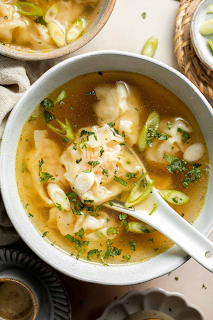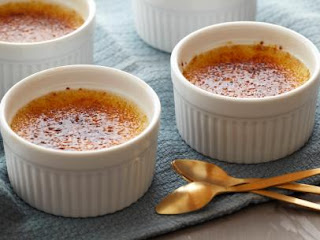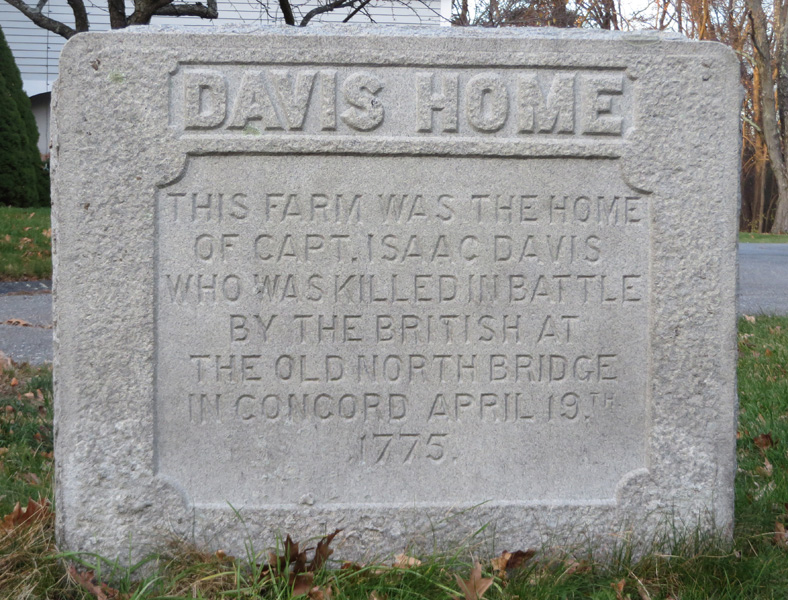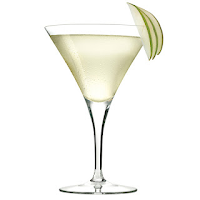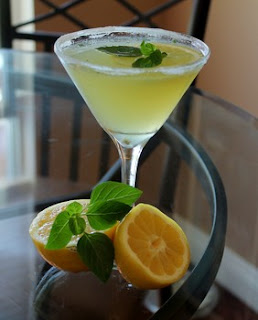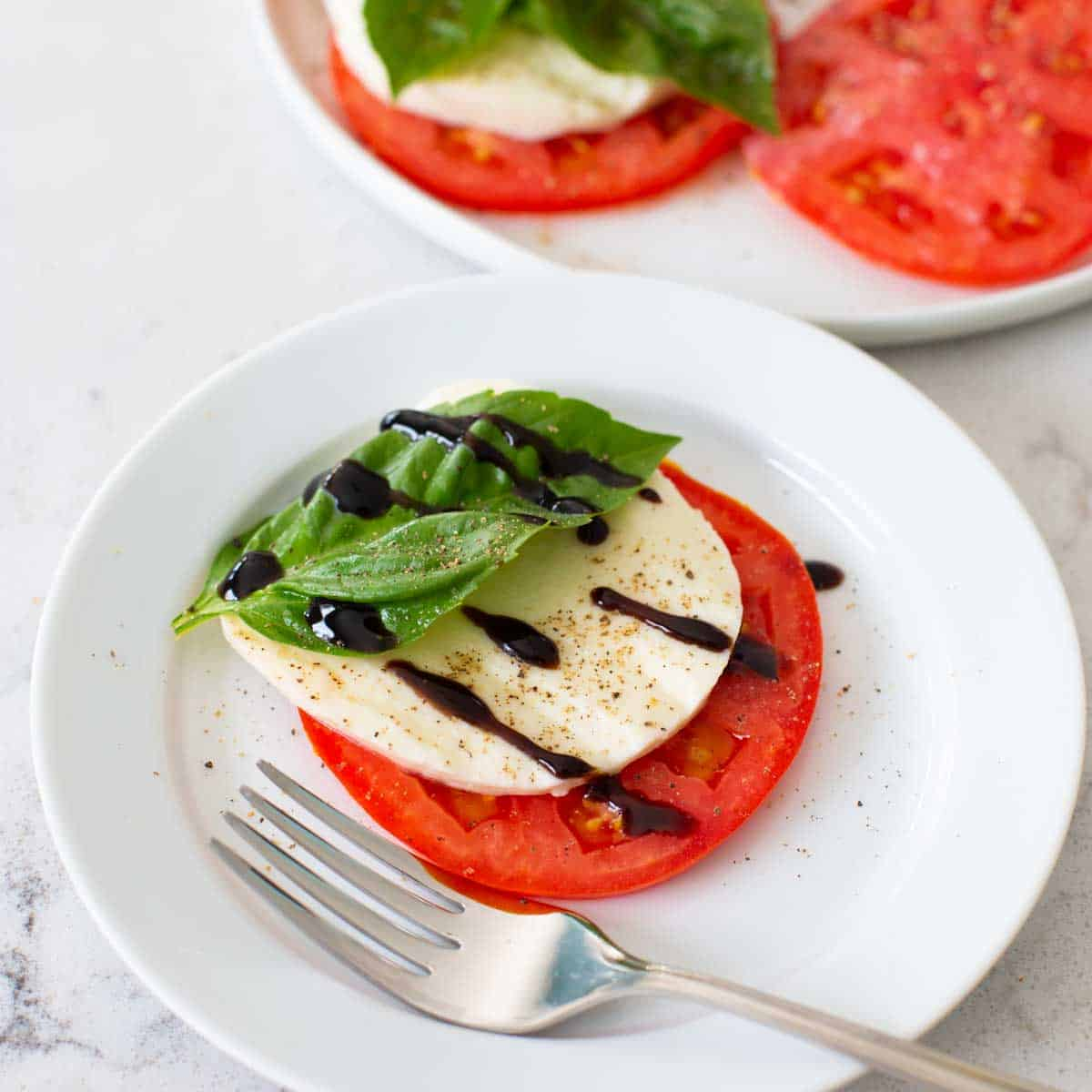Although there are many wonderful traditional cooking methods, techniques, and cuisines throughout the world, French cooking is generally considered the best of the best (I mean, "cuisine"?? is there any doubt??). I spent a few weeks in France a couple of years ago and I can attest that French cooking is delightful and delicious. So, similar to ballet, many French cooking terms are still in common usage throughout the world. Here are some of my favorite French cooking techniques and terms, along with definitions and a recipe or two that employs each technique!
Bouillon (BOO-yawn): A clear, seasoned broth, made from simmering meat, vegetables, and seasonings in water. The term is often used interchangeably with broth. Bouillon also refers to cubes and powders of concentrated, dehydrated broth. You can reconstitute this type of bouillon in water, or add the cubes/powder directly to soups and sauces for a flavor boost.
Example recipe: Shrimp Ramen Soup
1-2 tablespoons olive oil
8 ounces sliced mushrooms
1 large carrot, grated
4 cloves garlic, minced
4 cups beef, chicken, or vegetable stock (or reconstituted bouillon)
1 tablespoon freshly grated ginger
1 teaspoon soy sauce
1 teaspoon sesame oil
6 ounces ramen noodles
1 pound medium/large raw shrimp (thaw if frozen), cleaned and peeled
Cilantro and green onions for garnish, optional
In a large pot sauté mushrooms and carrot in olive oil for 5 minutes or until they start to soften. Add garlic and cook stirring for 30 seconds. Add broth, ginger, soy sauce, and sesame oil. Cover and bring to a boil. Once boiling, add noodles and shrimp. Cover and boil for 3 minutes. Serve topped with chopped green onions and cilantro if desired.
Example recipe: Wonton Soup
8-12 frozen wontons
5 cups water, divided
3 chicken bouillon cubes
¼ teaspoon salt
1 tablespoon soy sauce
½ tablespoon sesame oil
1 tablespoon fresh cilantro, chopped
1 teaspoon green onions, sliced
In a small saucepan, 4 cups of water, bouillon cubes, and salt, and bring to a boil over medium-high heat. Add wontons and cook until they float to the top, about 5 minutes. Add remaining cup of cold water and let the wontons float to the top again, about 5 more minutes. Add soy sauce and sesame oil and give the soup a gentle stir. Use a slotted spoon to scoop the wontons out and place into a large soup bowl. Top up with the soup base. Garnish with cilantro and green onions and serve hot.
Brulé (broo-LAY): Literally, "burnt," but used to refer to burning a food in order to caramelize the sugar on the surface.
Example recipe: Creme Brulée
Example recipe: Bourbon Brulee Pumpkin Pie
For the crust:
2 cups flour
1 tablespoon sugar
1 teaspoon salt
1 egg, lightly beaten
1/2 teaspoon white vinegar
1/4 cup ice cold water
3/4 cups cold butter, cut into pieces
1 egg white, lightly beaten
For the filling:
3 eggs
1 (15-oz) can pumpkin
¼ cup sour cream
2 tablespoons bourbon
2 teaspoons vanilla extract
1 teaspoon cinnamon
½ teaspoon salt
¼ teaspoon ginger
¼ teaspoon nutmeg
¼ teaspoon cardamom
1/8 teaspoon allspice
¾ cup maple syrup
1 cup heavy cream
3 tablespoons sugar
For the crust: Add the flour, sugar and salt to a food processor and pulse just until combined. In a small bowl, whisk together the egg, vinegar and water. Add the cold butter pieces into the food processor and pulse until small coarse crumbs remain. Sprinkle the water/egg mixture over the flour and pulse again until the dough comes together. Wrap in plastic wrap and chill for 30 minutes.
Preheat oven to 375F. Roll the pie crust out into a 12-inch circle. Fold in half and gently place in the plate, trimming excess. Cover with parchment paper and fill with pie weights or dried beans. Bake for 15 minutes, until barely golden. Brush lightly with a thin layer of egg wash. Reduce the oven temperature to 350F.
For the filling, in a large bowl whisk together all filling ingredients except maple syrup, cream, and sugar and set aside. Heat the maple syrup in a saucepan until simmering. Simmer for 2 to 3 minutes, until slightly thickened. Remove from the heat and gradually whisk in the cream. Whisk the maple mixture into the pumpkin filling until combined. Pour the filling into the pie crust and bake for 55 to 60 minutes, until the center is just set. Let cool completely, then refrigerate overnight. Before serving, sprinkle top with sugar and brulee with a kitchen torch or under the broiler.
Canapé (can-a-PAY): A bite-sized, layered hors d’oeuvre that translates to “couch.” Canapés start with a sturdy base layer (the couch) on top of which the main ingredients sit. The base was traditionally a small piece of toasted bread, but you can also use crackers, puff pastry (such as a small vol au vent), sliced vegetables (like cucumber rounds), or a slice of fruit. It should be something that guests can easily pick up from a tray and hold with their fingers.
Example recipe: Bruschetta with Balsamic Glaze
8 Roma tomatoes, diced
1/3 cup fresh basil, chopped (or chiffonaded; see below)
1/2 cup Parmesan cheese, grated, divided
2 cloves garlic, minced
1 tbsp balsamic vinegar
1 tsp olive oil
1/2 tsp salt
1/2 tsp pepper
8 slices French bread, cut to 1-inch thickness
In a small bowl, toss together tomatoes, basil, 1/4 cup parmesan cheese, garlic, balsamic vinegar, olive oil, kosher salt and pepper. Mix well. Cover and refrigerate until ready to serve. Just before serving, preheat oven to 400 degrees F. Line bread slices on a baking sheet and spoon the tomato mixture over the tops. Sprinkle remaining parmesan cheese over the tops. Bake in the preheated oven for 3-5 minutes, or until bread is lightly golden around the edges and the tomato mixture is warmed through.
Example recipe: Feta Hazelnut Crostini
2 medium apples, a sweet variety like Gala, Fuji, or Honeycrisp
¼ cup hazelnuts
1 ½ tablespoon honey
¼ cup feta cheese
¼ cup cream cheese
1 teaspoon lemon juice
1 teaspoon lemon zest
1 teaspoon honey
fresh thyme
Chop hazelnuts and toast in a dry skillet until lightly browned and fragrant. Remove from heat and let cool. Combine the feta cheese, cream cheese, lemon juice, lemon zest, and honey in a mini food processor or blender. Core apples and slice into ¼ inch thick slices. Toss in a ziplock bag with a little diluted lemon juice to avoid browning. Spread a little of the cheese mixture on each of the apple slices. Top with chopped toasted hazelnuts, drizzle with honey, sprinkle with a few fresh thyme leaves and serve.
Chiffonade (shif-uh-NOD): A knife technique for cutting leafy ingredients, such as spinach, broad-leafed lettuces, kale, and herbs, such as basil and mint. To make a chiffonade, stack and roll the leaves, and cut them into thin, ribbon-like strips. Chiffonade makes a beautiful and delicate garnish.
Example recipe: Grilled Chicken Caprese
4 chicken breasts
1 teaspoon Italian seasoning
1/2 teaspoon garlic powder
1/2 teaspoon onion powder
salt and pepper
4 slices mozzarella
4 slices tomato
2 tablespoons basil, chiffonaded
1/2 cup balsamic vinegar
2 tablespoons light brown sugar
[Note: Can substitute prepared balsamic glaze for the balsamic vinegar and brown sugar.]
Preheat grill to medium high heat. Season chicken breasts with Italian seasoning, garlic and onion powder. Sprinkle with salt and pepper on both sides. Spray the grill with non-stick cooking spray and cook the chicken breasts until they are almost fully cooked. Top each chicken breast with a slice of mozzarella. Close the grill and allow it to cook for a few additional minutes to melt. Remove the chicken from the grill and top with tomato and basil. Combine balsamic vinegar and brown sugar to make glaze, or use commercial glaze, and drizzle over chicken. Serve immediately.
Example recipe: Rainbow Pinwheels
4 large flour tortillas
1 cup hummus
1 red bell pepper, sliced thin
2 carrots, shredded or matchsticks
1 yellow bell pepper, sliced thin
1/2 cup baby spinach leaves, chiffonaded
1/2 cup red onion, sliced thin
Spread about ¼ cup hummus over each tortilla, leaving room on the edge. Arrange the vegetables on the hummus covered tortillas. Roll up each tortilla tightly and refrigerate several hours to overnight. Cut crosswise into pinwheels and serve.
Duxelles (dewk-SELL): Chopped mushrooms sautéed in butter with onions or shallots and herbs, such as parsley. Duxelles are often used in stuffings and fillings.
Example recipe: Beef Wellington
1 (about 2-pound) beef tenderloin
Salt and freshly ground black pepper
2 tablespoons olive oil
3 tablespoons Dijon mustard
1 pound mushrooms, finely chopped ("duxelles")
2 shallots, finely chopped
2 cloves garlic, minced
2 sprigs fresh thyme, leaves only
1/2 cup dry white wine
4-6 slices prosciutto
1 pound puff pastry, thawed if frozen
1 large egg, beaten (for egg wash)
Season the beef tenderloin generously with salt and pepper. Heat the olive oil in a large skillet over high heat. Sear the beef on all sides until well browned, about 2 minutes per side. Remove from the skillet and let cool. Brush the cooled beef tenderloin with Dijon mustard, coating it evenly. In the same skillet used to sear the beef, add the chopped mushrooms, shallots, garlic, and thyme. Cook over medium heat, stirring occasionally, until the mushrooms release their moisture and the mixture becomes dry, about 10-15 minutes. Deglaze the skillet with the white wine, scraping up any browned bits from the bottom. Cook until the wine has evaporated. Additionally, remove the mushroom mixture from the heat and let cool. Lay out a sheet of plastic wrap and arrange the prosciutto slices on top, slightly overlapping. Spread the cooled mushroom mixture evenly over the prosciutto. Place the beef tenderloin on top of the mushroom mixture and roll it up tightly using the plastic wrap. Chill in the refrigerator for at least 30 minutes.
Preheat the oven to 425°F (220°C). Roll out the puff pastry on a lightly floured surface into a large rectangle, large enough to encase the beef tenderloin. Unwrap the chilled beef tenderloin from the plastic wrap and place it in the center of the puff pastry. Fold the pastry over the beef, sealing the edges tightly. Trim off any excess pastry and crimp the edges with a fork to seal. Transfer the beef Wellington to a baking sheet lined with parchment paper, seam side down. Brush the pastry with beaten egg for a golden finish. Bake in the preheated oven for 35-40 minutes, or until the pastry is golden brown and the beef reaches your desired level of doneness. Let the Wellington rest for 10 minutes before slicing and serving.
Example recipe: Stuffed Acorn Squash
½ cup uncooked wild rice
1 teaspoon kosher salt, divided
3 small acorn squashes, 1 pound each, cut in half and seeds scooped out
1 tablespoon extra-virgin olive oil
1 medium shallot, finely chopped
3 large cloves garlic, minced
8 ounces baby bella cremini mushrooms, finely chopped
½ teaspoon ground black pepper
1 (15-oz) can chickpeas, drained and rinsed
⅓ cup dried cranberries
¼ cup chopped pecans
1 tablespoon fresh thyme leaves, chopped
Bring 1 1/2 cups water to a boil in a small saucepan. Add the rice and 1/2 teaspoon kosher salt. Reduce heat to low, cover, and let simmer until the rice is tender, about 55 minutes. Drain off any excess liquid. Set aside.
Place the halved squash on a baking sheet brushed with olive oil, cut sides down, and bake at 425 for 25 minutes. Turn each squash over, brush with additional olive oil and season with salt and pepper, then return to oven and bake for an additional 20-25 minutes. If you prefer to cook in an Instant Pot, add squash and 1/2 cup water to Pot, then cook on high pressure for 4 minutes, followed by a 5-minute natural release.
While squash is cooking, heat olive oil in a large skillet over medium-low heat and saute shallot until softened, about 4 minutes. Add garlic and cook for 30 additional seconds, until fragrant. Add mushrooms, pepper, and remaining 1/2 tsp salt. Increase heat to medium and cook until the mushrooms are softened and browned, about 5 to 7 additional minutes. Add the chickpeas, cranberries, pecans, thyme, and cooked rice and stir to heat through, about 2 additional minutes. Taste and adjust seasonings as desired. Spoon the hot filling into the squash halves and serve.
Flambé (flahm-BAY): Foods containing strong alcohol (such as brandy, cognac, or rum) that are ignited. The flame extinguishes as the alcohol cooks out of the dish. Well-known flambéed dishes include Crêpes Suzette, Bananas Foster, and Cherries Jubilee.
Example recipe: Roast Beef Tenderloin with Cognac Dijon Sauce
1 pound beef tenderloin (preferably center cut, trimmed of all silver skin)
½ teaspoon kosher or sea salt
½ teaspoon ground black pepper
½ - 1 teaspoon minced garlic
1 tablespoon olive oil
⅓ cup cognac or brandy
½ cup creme fraiche
1 tablespoon Dijon mustard
2 teaspoons fresh chopped thyme or tarragon
Allow the beef to stand at room temperature for 45-60 minutes. Tie with kitchen twine at about 1″ intervals. Liberally sprinkle all sides with kosher salt, pepper, and garlic. Rub with olive oil. Pre-heat oven to 400 degrees. Cover a rimmed baking sheet with foil, top with a wire rack and set aside. Place a heavy skillet or fry pan over medium-high heat. Sear the beef on all sides, turning when a brown crust forms. After sides are seared, turn briefly on the ends to sear them as well. Place beef on the wire rack and set the pan aside (do not wash). Roast the beef until it reaches an internal temperature of 125 degrees for rare, 130-135 for medium-rare, or 140-145 for medium. Test at about 18-20 minutes and roast longer if needed. Allow to rest in a warm place for 15-20 minutes, then remove twine and slice.
Return the pan in which you seared the beef to medium heat. Pour off fat. Remove pan from heat and add the cognac, then return pan to heat and stir, deglazing the pan. Allow the cognac to cook down for a minute or two, then whisk in creme fraiche. When smooth, add the Dijon and tarragon. Season with salt and pepper to taste.
Example recipe: Crepes Suzette
For the batter:
2 eggs, room temperature
½ cup + 2 tablespoons flour (80g)
1 tablespoon sugar
1 pinch salt
½ teaspoon vanilla extract
2 tablespoons Grand Marnier
1 teaspoon lemon zest
1 teaspoon orange zest
3 tablespoons butter, melted
¾ cup + 1 ½ tablespoons milk
1 tablespoon water
For the sauce:
2-1/2 tablespoons butter
2 tablespoons sugar
½ cup orange juice
¼ cup Grand Marnier
orange peel
Whisk together all crepe batter ingredients except milk and water in a large bowl. Add half of the milk, gradually adding the remaining milk and water, and mix to get a smooth batter. Cover the bowl with a plastic film and let rest at room temperature for one hour. Cook crepes in a nonstick crepe pan (no need to grease). Cook both sides of crepes until lightly browned, about 1 minute on each side. Repeat until all the batter has been used.
To make the sauce, melt butter and sugar in a pan until the sugar begins to caramelize. Add orange juice, Grand Marnier, and orange peel, and bring to a boil. Fold each crepe twice and place 4-6 of them in the pan with the sauce. Cook for a few seconds and turn them over.
To flambé, remove the pan from heat, add some Grand Marnier, and ignite carefully. Scratch a long-handled match and approach the hot sauce. Flames will appear for a few seconds. Once the alcohol burns off, the flames will disappear.
Fondue (fon-DEW): Traditionally, warm, melted cheese and white wine emulsion of Swiss-French origin, served in a pot (a “caquelon”), and used as a dip for skewered bread cubes. Popularly, warm, fluid dip, served in a pot, such as melted cheese, chocolate, and seasoned broth.
Example recipe: Cheese Fondue
4 teaspoons cornstarch, divided
1 cup plus 1 tablespoon dry white wine, divided
1 1/2 cups Gruyere cheese
1 1/2 cups shredded Swiss cheese
1 peeled garlic clove, halved
1 1/2 teaspoons lemon juice
1/8 teaspoon garlic powder
1/8 teaspoon dried oregano
1/8 teaspoon Worcestershire sauce
3-4 drops hot sauce (optional)
Dippers: bread cubes, apple slices, baby carrots, cauliflower, broccoli, soft pretzel chunks
Combine 2 teaspoons of cornstarch with 1 tablespoon of the wine in a small bowl and set aside. Combine the remaining cornstarch with the cheese and set aside. Rub the sides of a large saucepan with the cut side of the garlic. Discard the garlic cloves. Add the remaining wine to the large saucepan and heat over medium heat. Cook it until bubbles form around the sides of the pan. Stir in lemon juice. Reduce heat to medium-low. Add a handful of the cheese mixture to the saucepan. Stir constantly, using the figure-eight hand motion, until the cheese melts completely. Continue adding the rest of the cheese, one handful at a time. Allow cheese to melt completely between additions. Once the cheese mixture has been added, stir in the garlic powder, oregano, Worcestershire sauce, and hot sauce. Gradually stir the cornstarch mixture in the pan. Stir and cook until the cheese fondue is smooth and thickened. Keep warm and serve with dippers.
Example recipe: Roasted Garlic Fondue for Beef or Game
3 heads garlic
3 tablespoons olive oil
1 onion, finely chopped
1/2 cup red wine or sherry
6 cups chicken broth
Salt and pepper
Bite-sized cubes of steak, duck, rabbit, venison, or chicken
Bite-sized pieces of potatoes, carrots, mushrooms, broccoli, zucchini, or other vegetables
Preheat oven to 400 F and place the rack in the center position. Slice the top of each garlic head. Place individually on aluminum foil sheets and drizzle with 1 tablespoon of oil. Close the foil and bake for 50 minutes or until garlic is tender and caramelized. Press the cooked head of garlic to bring out the garlic purée. Set aside.
While garlic is cooking, in saucepan, brown the onion in the remaining oil. Deglaze with the wine and reduce by half. Add the broth and garlic purée. Bring to a boil and simmer about 5 minutes. Season with salt and pepper. Keep warm in a fondue pot or over a Sterno burner. Cook cubes of meat and vegetables on skewers or fondue forks for 1-2 minutes, or to desired doneness.
Gratiné/au Gratin (GRAH-tee-nay / oh grah-TAHN): Dishes that are baked or broiled with a crust of breadcrumbs and/or cheese. “Gratin” derives from the French verb, “gratter,” which means, “to scrape.” Many recipes you’ll see described as au gratin or gratinéed are prepared in casserole or shallow baking dishes with a creamy sauce.
Example recipe: Copycat Ruth's Chris Potatoes au Gratin
2 tbsp butter (plus extra for greasing the dish)
1/2 medium onion, minced
1 clove garlic minced
1-1/4 tsp salt
1/2 tsp ground black pepper
3/4 cup chicken stock
1-1/4 cups heavy cream
1-1/2 to 1-3/4 lbs russet potatoes (about 5-6), peeled and sliced 1/8 inch thick
2 cups shredded cheddar
3/4 cup shredded Fontina or Provolone
1/4 cup Parmesan
1 tbsp chopped parsley (optional)
Preheat oven to 425°F. In a large skillet over medium heat, melt 2 tablespoons of butter. Add the minced onion and cook for about 5 minutes until soft, then add garlic, salt, and pepper. Cook for an additional 30 seconds until fragrant. Pour in the chicken stock and heavy cream, stirring to combine. Add the sliced potatoes, ensuring they are well-coated in the sauce. Increase the heat and bring the mixture to a simmer. Cover, reduce heat to medium-low, and cook until the potatoes are nearly tender, about 15-20 minutes. Stir occasionally. Butter an 8x8-inch baking dish. Transfer the potatoes and sauce to the prepared baking dish, spreading evenly. Top with an even layer of shredded cheese mixture. Bake for 10-15 minutes, or until the cheese is melted and golden brown. Let the dish rest for a few minutes before serving. Sprinkle with chopped parsley if desired and serve warm.
Example recipe: Creamy Vegetables au Gratin
2 medium beets
2 medium yellow squash
2-3 medium potatoes
1 large and long sweet potato
3-4 small parsnips
3-4 large sprigs of fresh thyme
1 cup heavy whipping cream (or half and half)
1 cup parmesan cheese
1 cup sharp white cheddar, shredded or crumbled
Salt and pepper to taste
Preheat the oven to 400F. Slice all vegetables thinly, preferably on a mandolin. Keep the beets separate to avoid bleeding. Pour ½ of the cream and ½ of the parmesan into the bowl with the squash, potatoes, and parsnips. Add ¼ cup of parmesan and just enough cream to the beets to moisten them. Add salt, pepper, and thyme to both bowls. Add the remainder of the cream and parmesan to the bottom of an greased 9x13-inch pan. Lay all vegetables in the pan in rows. Add the cheddar to the top with black pepper and more thyme if desired. Cover with foil and bake for 30-40 minutes. Let sit for 10-15 minutes before serving.
Julienne (joo-lee-EHN in English; ZHOO-lee-ehn in French): A knife technique of cutting food (usually vegetables) into small, thin strips, also sometimes called "matchstick."
Example recipe: Chickpea Apple Broccoli Salad
1 head broccoli, very finely chopped
1 (15 ounce) can of chickpeas, rinsed and drained
2 cups diced or julienned honeycrisp apples
1 cup shredded or julienned carrots
⅓ cup diced green onion
⅓ cup dried cherries or craisins
⅓ cup chopped pecans
½ cup chopped flat leaf parsley
3 tablespoons olive oil
1 ½ tablespoons apple cider vinegar
1 tablespoon dijon mustard
½ tablespoon honey
1 clove of garlic, minced
Freshly ground salt and pepper, to taste
Extra cherries/craisins and pecans (optional), for garnish
In a large bowl, add finely chopped broccoli, chickpeas, apples, carrots, green onion, dried cherries/craisins, pecans, and parsley. Set aside. In a small bowl, whisk together olive oil, vinegar, mustard, honey, garlic, salt and pepper. Immediately drizzle over salad and toss to combine. Season with salt and pepper as needed. Garnish with extra cherries/craisins and pecans and serve immediately or refrigerate.
Example recipe: Roasted Carrots and Green Beans
½ lb carrots, julienned
½ lb green beans, washed and trimmed
1-2 tablespoon vegetable oil
½ teaspoon garlic powder
¼ teaspoon dried thyme
¼ teaspoon dried oregano
¼ tsp salt
⅛ teaspoon pepper
Preheat oven to 400°F. Line a baking sheet with non-stick foil or parchment paper. In a large bowl, toss together carrots, green beans, oil, garlic powder, thyme, oregano, salt, and pepper. Spread vegetables onto prepared baking sheet in a single layer, making sure to not overcrowd the sheet. Roast for 10-15 minutes until you reach your desired doneness, stirring halfway.
Lardons (lahr-DOHN): Small strips of slab bacon, usually around 1/4-inch wide and thick. The shape and thickness of the cut renders fat particularly well, creating crispness yet retaining meatiness.
Example recipe: Bacon, Potato, and Egg Casserole
1 lb bacon, cut into lardons (1/2-inch strips)
1 yellow onion, diced
1 bell pepper (red, yellow, or orange), seeds removed and diced
3 cloves garlic, minced
12 large eggs
1 cup milk
3 cups frozen diced or shredded potatoes (no need to thaw)
2 cups shredded cheddar cheese, divided
1 1/2 teaspoons salt
1/2 teaspoon black pepper
2 green onions, chopped (optional)
Preheat oven to 350°F. Grease a 9×13 baking dish and set aside. In a large skillet, cook bacon over medium heat, stirring occasionally, until crispy and brown. Remove bacon with a slotted spoon and place on a paper towel lined plate and set aside. Add the onion and red pepper to the skillet and cook over medium heat until tender. Add the garlic and cook for 2 minutes. Set aside. In a large bowl, beat the eggs and whisk in the milk. Stir in the cooked vegetables, potatoes, and 1 cup of the shredded cheese. Set ¾ cup of bacon aside and stir in the rest. Season with salt and pepper. Pour the mixture into the prepared baking dish and top remaining cheese and green onions. Bake for 20 minutes so the eggs start to set up. Carefully add the remaining bacon to the top of the casserole. Bake for an additional 20 tot 30 minutes or until the eggs are firm and the top is slightly golden brown. Let stand for 10 minutes. Cut into squares and serve warm.
Example recipe: Classic Wedge Salad
Roux (roo): A paste of equal parts of flour and melted fat (classically, butter), cooked together and used to thicken liquids, such as sauces.
Example recipe: Lobster Mac & Cheese
1 pinch of salt
1 teaspoon vegetable oil
1 16 ounce package cavatappi, rotini, farfalle, or elbow macaroni
4 cups milk
1 stick butter, divided
1/2 cup flour
12 ounces Gruyere, grated
8 ounces extra sharp cheddar, grated
1/2 teaspoons ground black pepper
1/2 teaspoon nutmeg
24 ounces lobster, cooked (can also use crab, breaded chicken bites, or omit entirely)
1 1/2 cups bread crumbs or panko
Preheat the oven to 375 degrees. Bring a large pot of salted water to the boil and add a little oil. Add the pasta and cook according to the package instructions, around 6 to 8 minutes. Drain well. Meanwhile, gently warm the milk in a small saucepan. Melt 6 tablespoons of the butter in a large pot and whisk in the flour to make a roux. Cook for 2 minutes over a low heat, whisking continuously. Whisk in the hot milk and cook for a couple more minutes, until smooth and thickened. Remove from the heat and stir in the cheeses and seasonings. Add the cooked pasta and lobster (if using) and stir well. Spoon the mixture in 6 to 8 greased ramekins or a large greased casserole dish. Melt the remaining 2 tablespoons of butter and stir in the bread crumbs. Sprinkle on the top of the pasta mixture. Bake for 30 to 35 minutes, until the sauce is bubbly and the top is golden brown.
Example recipe: Creamed Onions
2 (8-oz) jars pearl onions
3 tablespoons butter
4 tablespoons flour
1 cup water
1-1/2 cups milk
salt to taste
ground black pepper to taste




